
Animal Bite and Sting Wound Treatment Page Menu: 1 2 3 4 5 6 7 <<First
Treating Animal Bites and Stings in the Golden Age of Piracy, Page 7
Specific Venomous Animal Wound Care
In addition to providing a generic cure for venomous wounds, several authors discuss cures for venomous wounds by specific animals. Among those relevant to sea travel are wounds by bees and wasps, scorpions, snakes, spider and stingrays.
Specific Venomous Animal Wound Care - Bees & Wasps
"Bees, Wasps, Hornets and such like, caus great pain in the skin wounded by their stinging, by reason of the curstness [cursedness] of the venom which they send into the bodie by the wound, yet are they seldom deadlie, but yet if they set upon a man by multitudes, they may com to kill him."1
Ambroise Paré goes on to say, "Great pain presently ariseth, which continueth until the sting left in the part is taken forth, the part becom’s red and swoln, and there riseth a push or little blister."2
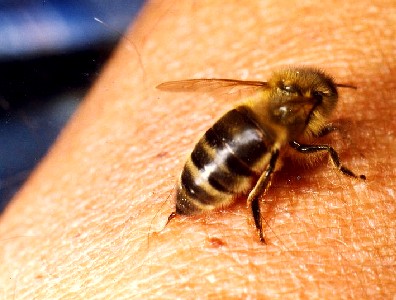
Photo: Diego Haettenschwiler
Most of the authors who suggests a remedy agree that the first step in treating bee and wasp stings is to remove the sting if it remains in the skin. Stephen Bradwell believes this point is so important that he repeats it three times.3
Paré explains the procedure for removing the sting, explaining that that the surgeon is
forthwith to suck the wound Verie hard, and thereby to draw forth the stings, which if they cannot thus bee gotten out, the place, if nothing hinder, is to bee cut, or els temper ashes with leven or oil, and so supplie them: the part also may bee verie conveniently put into hot water, and there fomented for an houres space, and at length washed in sea-water4
Bradwell gives advice that agrees with this in several points: "If the Sting will not easily be gotten out, lay to it a poultis [poultice: soft moist mass] made of leaven [yeast], wood-ashes, and sallet [salad] Oyle mixed together. Or bath it with Childes urine good and hot."5
With the sting removed, Bradwell says the location is to be washed in the same manner as other venomous wounds.
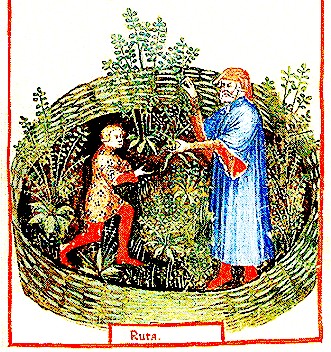
Rue, From Tacuinum of Paris (14thc)
This wash is similar to those discussed previously, containing "a little water & salt mixed with the juice of Rue [Ruta graveolens]"6. Rue was reputed to be an alexipharmic, or antidote for poisons.7
A variety of medicinal applications to the wound were recommended, with each author who discusses bee and wasp stings having their own suggestions. Paré advises the application of 'beaten' cresses to the wound because they are "asswage the pain and discuss [disperse] the humor causing the tumor."8 There are several types of cresses, with water and garden cresses being the most likely candidates for use here. Apothecary John Quincy says that garden cresses are "only us'd in Sallets (salads]" and types other than water cresses are "not used in Medicine."9 Water cresses were said to be cleansing and antiscorbutic.10
Paré lists a variety of other medicines which he says are effective including: ox-dung soaked in oil and vinegar, mashed up bee/wasps, vinegar mixed with honey and salt, naturally occurring sulfur mixed with spit and the juice of unripe figs with honey and treacle.11
German surgeon Matthias Gottfried Purmann lists a variety of medicines appropriate for bee and wasp stings. He says "there can be no better Remedy than Rabus Sambuci [red elder] mixed with Camphorated Spirit of Wine immediately applyed."12 The inclusion of elder trees in Purmann's remedy is interesting primarily because it has not come up previously in this article. Physician Robert James states in his pharmacopoeia that "the Elder is at once more safe and efficacious, than [either] the celebrated artificial [poison] Antidotes Theriaca [treacle] and Mithridate."13
Like Paré, Purmann goes on to list a variety of other topical medicines that can be used in such wounds. These include 'fresh' earth, a cataplasm consisting of "Rue, Bay leaves, Mallows [flowering plants from the the family Malvacea], and the Roots of Marsh-Mallows, mixed with Oil of Olives and Vinegar",
Photo: Szabolcs Turuczki - Swamp Cypress Roots
another cataplasm made from "Theriaca, Cepæ [onion], Scordium [water germander], Caro Viperina [viper skin] & rad. Cyper. [cypress root] ", a plaster consisting of linseeds, salt and vinegar and, lastly, a mixture of nightingale feces, thyme and melilot.14 Once again, Purmann's suggestions contain a variety of herbs and medicinals which were used in the generic cure of venomous wounds. One unusual ingredient in his list is cypress root, which was said to be dry, cool, astringent and somewhat healing.15
Physician Stephen Bradwell suggested first either cauterizing the wound or sucking the venom out of it. "[A]fter that, apply to it a little lint dipped in old Andromachus Treacle [Greek treacle] mixed with Honey; and over it, as also over all the swelling, lay a poultis made of fresh Cow-dung mixed with Barrowes grease [hog's lard], or sallet Oyle [oil and vinegar]."16 Bradwell later explains that the honey will protect the wound from the air, which was believed to cause infection. He also advises the use of mithridate mixed with honey or "for the poorer sort, fresh Cow-dung or dogs dung mixed with sallet Oyle."17
Bradwell also recommends an oral antidote such as those he suggested for use in other envenomed wounds. To those, he adds: "Garlicke boyled in white wine, or strong ale. Or els, the seeds and roots of Lillies boyled in Beere. Or the seeds of Mallowes boyled in water, and whitewine, with a little Vinegar."18 Most of these ingredients should now look fairly familiar.
Paré also suggests a preventative medicine for warding off wasps. "Wasps will not sting nor bite such as annoint their bodies with the juice of mallows mixed with oil. They may bee quickly chased away with the fume of brimstone and such like things.”19
1,2 Ambroise Paré, The Workes of that Famous Chirurgion Ambrose Parey, 1649, p. 521; 3 See Stephen Bradwell, Helps For Suddain Accidents Endangering Life, 1633, p.39, 46-7 & 48; 4 Ambroise Paré, The Workes of that Famous Chirurgion Ambrose Parey, 1649, p. 521-2; 5,6 Bradwell, p. 47; 7 John Quincy, Pharmacopoeia Officinalis & Extemporanea, 1719, p. 90; 8 Paré, p. 522; 9 John Quincy, p. 143; 10 Quincy, p. 143 & Nicholas Culpeper, Pharmacopœia Londinesis, 1720, p. 33; 11 Paré, p. 522; 12 Matthias Gottfried Purmann, Churgia Curiosa, 1706, p. 187; 13 Robert James, Pharmacopœia universalis, 1747, p. 428; 14 Purmann, p. 188; 15 James, p. 307; 16 Bradwell, p. 47; 17,18 Bradwell, p. 47; 19 Paré, p. 522
Specific Venomous Animal Wound Care - Scorpions
Scorpion stings are discussed by several surgeons, although only French surgeon Ambroise Paré gives much detail on them. He starts by saying only some of them are deadly, depending on
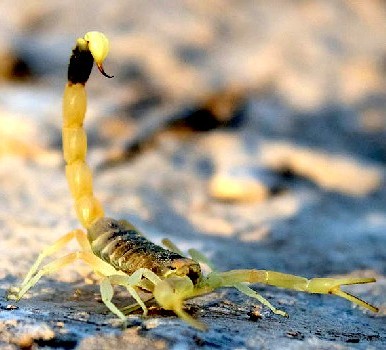
Photo: Wiki User Minozig - Deathstalker Scorpion (Leiurus quinquestriatus)
where they are found. "In Tuscanie and Scithia they are absolutely deadlie, but at Trent, and in the Island Pharos their stinging is harmless."1 In truth, most scorpion stings are not deadly. "Worldwide, only about 30 of the estimated 1,500 species of scorpions produce venom toxic enough to be fatal."2
Paré also provides quite an extensive description of the symptoms that accompany a venomous scorpion sting. He says it turns red, becomes hardened and swells with the patient showing feverish signs. He explains that the victim "is one while hot, another while cold, labor presently wearie’s him, and his pain is som-whiles more, and som-whiles less, hee sweat’s and shake’s as if hee had an Ague, his hair stand’s upright, paleness dis-color’s his members"3. He adds that the patient can also have dry heaves, constipation, gas, fainting spells and the feeling that pins and needles pricking their skin.
The cure of scorpion stings was most widely said to be oil of the the scorpion itself. Matthias Gottfried Purmann advises "the Stinging of Scorpions are generally cured by the application of its Oil, or the Scorpion itself after it has been squeez’d."4 Fellow German William Fabry recommended the same thing. Paré similarly commented, "It is an usuall, but certain remedie to anoint the stung place with the oil of Scorpions."5
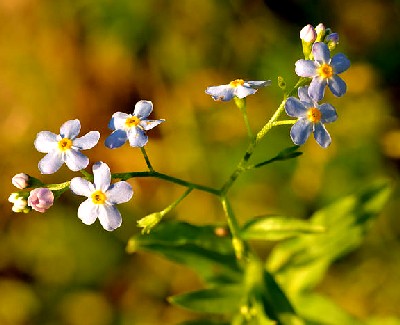
Photo: Ivar Leidus - Myosotis Scorpioides Flowers
Paré does not limit himself to oil of scorpions, however. He makes several other suggestions including the use of several now familiar medicinals. These include "the milkie juice of figs", calamine, barley meal combined with rue [Ruta graveolens], naturally occurring sulfur combined with turpentine and made into a plaster, the herb Myosotis scorpioides ("which thence took its name") and "a bryonie-root boiled and mixed with a little sulphur and old oil"6. He also suggests that "Snails beaten together with their shells, and laid thereon, presently asswage pain."7 After reciting all those various ingredients and compound concoctions, he undercuts them all with, "Yet the continual use of a bath stand’s in stead of all these, as also sweat [making the patient sweat], and drinking wine som-what allai’d."8
Some of the most unusual treatments for scorpion stings come from missionary Domingo Navarette who reported on the treatments he witnessed during his travels in Mexico.
We us’d another Remedy besides, which was to rub all about the Beds with Garlick. We were assur’d there, that it was a try’d and certain Remedy against this sting and the pain of it, to stroke the part that was hurt with a Child’s private Member which immediately takes away the Anguish and then the Venom exhales. The moisture that comes from a Hen’s Mouth is good for the same.9
While some of their cures for other types of venomous bites and stings are a bit bizarre, none of the period surgeons advise such curious treatments for scorpion stings.
1 Ambroise Paré, The Workes of that Famous Chirurgion Ambrose Parey, 1649, p. 521; 2 "Scorpion Sting", mayoclinic.org, gathered 11/11/16; 3 Paré, p. 521; 4 Matthias Gottfried Purmann, Churgia Curiosa, 1706, p. 187; 5,6,7,8 Paré, p. 521; 9 Domingo Navarrete, The Travels and Controversies of Friar Domingo Navarrete 1618-1686, 1962, p. 42
Specific Venomous Animal Wound Care - Snakes
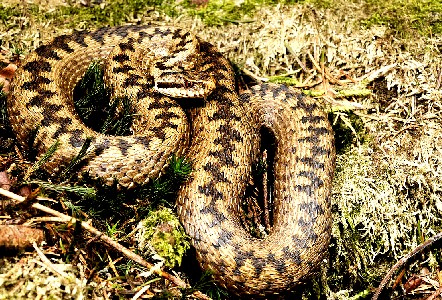
Photo: Benny Trapp - Common European Adder (Vipera Berus )
Treatment of venomous snake bites is divided by most authors by the type of snakes that bit the victim.
Ambroise Paré and James Cooke both discuss the bites of vipers and adders. Although word meanings during this time in history were much less precise than they are now, it is interesting to consider the difference between vipers and adders. The word 'viper' refers to a wide variety of venomous snakes and is rather imprecise. The Oxford Dictionary says that adders are "A small venomous Eurasian snake which has a dark zigzag pattern on its back and bears live young. It is the only poisonous snake in Britain."1
Paré gives the most thorough analysis of viper and adder bites. He starts by noting the symptoms, which begin with "a pricking pain, that part at the first is much swollen, and then the whole bodie, unless it bee hindred". Blisters arise, the wound weeps 'gross and bloody filth' and is painful. As time passes, and the poison presumably moves inward, "great inflammation possesseth the liver and the gums", the patient become very dry, pale and yellow,
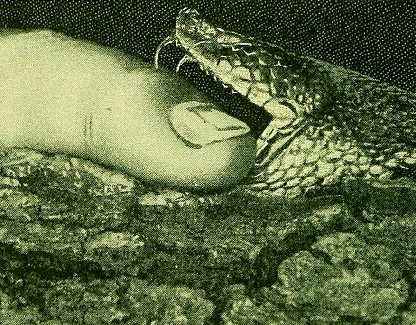
From The Human Body and Health, By Alvin Davison (1908)
unquenchable thirst develops, pain in the stomach, vomiting, hiccups,and fainting. He warns that the patient will eventually die, "unless you provide by fit medicines for the noble parts [viscera], before the poison shall invade them."2
Surgeon James Cooke recommends a regime of cure, relying on medicines. He says first to put the 'rottenest Egg that can be got" on the wound. He then recommends his own compound oral medicine be given:
Rx. Rut [rue - Ruta graveolens] Allii [garlic] {of each, a handful} coq. in [cook in] Cerevis. Fortis [strong brewer’s yeast] q.s. [as much as needed] Colat. [strain] add. Bol. Opt. pul. [add a powdered bole opiate - bole here refers to a single dose compound medicine containing laudanum3] {1 ounce} Moloss. [molasses] {1 ounce} coq. parum [cook for a short time]; {dose from 4 ounces to ½ pound}, warm4
He then orders the surgeon to "Provide it as soon as possible, fast three hours after its taking, drink no other for twenty four hours: this is admirable."5
Cooke goes on to suggest a wide variety of other things that can be administered orally for the same purpose. These include wine made of the 'Flesh of Adders', meats cooked in garlic, drinks with strawberries in them, holding a red hot iron near the part
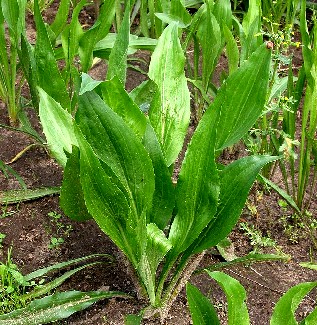
Photo: Wiki User Rasbak - Scorzonera Hispanica
and a dram of another custom compound medicine served in wine:
Rx. Rad. Gentian [gentian root] {1/2 ounce} Contrayerv[a]. [roots of tropical species of Dorstenia] Scorzon[ara]. [probably viper's grass - scorzonera hispanica] {of each, 2 drams} [Teucrim] Scord[ium]. {3 drams} Rut. [rue] {2 drams} Piper. Nigr. [black pepper] {4 scruples} Croc[i]. [saffron] {1 scruple} M. f. pul. [make into a powder] Dos[e]. {1 dram} in Vin. alb [white wine].6
Once the medicines have been administered, Cooke states that a tourniquet is to be placed above the wound, the wounded member is to be held up to prevent circulation and then deeply scarified [incised around the edges of the wound] and cupped. This is to draw the poison out before it can enter into the rest of the body. (Note that the word 'tourniquet' was not yet in use, but is inferred from Cooke's description of what was to be done.) After cupping it, the wound is to be washed and bandaged.
French surgeon Ambroise Paré gives an account of being bitten by a viper and then treating himself.
...forthwith I straitly [tightly] bound my finger above the wound above the wound [effectively creating a tourniquet], that so I might press forth the blood and poison, lest they should diffuse themselvs further over the bodie. I dissolved old treacle [theriac] in aqua vitæ. wherein I dipped and moistned cotton, and so put it to the wound, and within a few daies I throwly [thoroughly] recovered by this onely medicine.7
He goes on to recite other methods of treatment which can be used for viper wounds starting with mithridate. In addition are "sundrie other things, which by reason of their heat are powerful drawers", including combinations such as garlic and leeks, barley flower and vinegar as well as honey and goat feces. "Some think it sufficient forthwith to wash and foment the wound with vinegar, salt, and a little honie."8
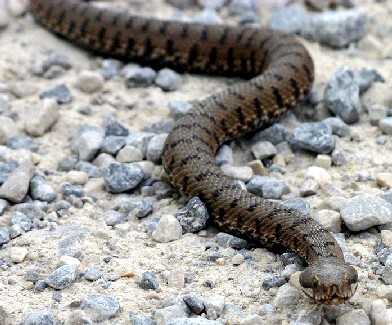
Photo: Werner Seiler - A European Asp (Vipera Aspis)
Paré also provides a separate treatment regime for asps, which are yet another type of viper, these being defined as "small southern European viper[s] with an upturned snout."9 This is often used to refer to Egyptian cobras as well.
Paré begins his treatment by listing the symptoms of an asp's bite. These include a sudden darkening of vision, agitation, stomach pains, forehead and cheek twitching, drooping eyelids and a small amount of black blood seeping from the wound. Paré warns that within eight hours of receiving the wound, death "will take them away by convulsions, unless you make resistence with fitting remedies."10
If the wounded area turned purple, black or green, he warned that "the native heat is extinct and suffocated by the malignity of the venom. Therefore then it is best to amputate the member, if the partie bee able to endure it, and there bee nothing which may hinder."11
Paré also provides a theory about how asp venom works, suggesting that it congealed the patient's blood. As a result, the surgeon had to use medicines that were "hot and subtil of parts, as mithridate or treacle dissolved in aqua vitæ, and the same powred into the wound [with a syringe]; the patient must be warmed by baths, frictions [rubbing the part], walking, and the like."12
He also recommended an antidote to asp venom which he indicates is preferable to everything else.
Photo: Victor Selvas - Melilotus Officinale
...this medicine is composed of the leavs of Mullot [melilot], Avenes [oats] and red-stock-gilliflow[e]rs [unspecified fragrant red flowers] in like quantitie, which they boil in sharp vinegar and the urine of a sound man, and therewith foment the wounded part. Yet if hee have not taken nor used anie thing of a good while after the wound, it will be better and more certain, if the patient drink three ounces of this decoction fasting two hours before most.13
Paré also provides a case study which presents an interesting problem that can occur with venomous snake bites. A man bitten on the hand by an unspecified venomous snake stuck the wounded hand in his mouth because it hurt. "[H]is tongue forthwith swelled so big, that hee could not speak his minde: besides, his whole arm, even to his shoulder, was in like sort much swelled, his pain was so vehement, that it made him swoun [faint] twice in my presence"14.
Paré gave his patient treacle in white wine and aqua vitae to drink and then put him in a warm bed to sweat out the venom, making sure he remained awake, "lest sleep should draw the poison inwards to the entrails."15 He kept the victim's wound open, washing it regularly with treacle. The man recovered from the wound in a few days time.
While sea surgeon John Woodall doesn't provide a specific regime for snake bites, he does say that carduus benedictus or blessed thistle is useful in resisting poisons in the body "and prevaileth against biting of Serpents."16
1 "viper", oxfordictionaries.com, gathered 11/11/16; 2 Ambroise Paré, The Workes of that Famous Chirurgion Ambrose Parey, 1649, p. 515-6; 2 For examples, See the section tiled 'Opiates' in John Quincy, Pharmacopoeia Officinalis & Extemporanea, 1719, p. 610-1; 4,5,6 James Cooke, Mellificium Chirurgiæ: Or, The Marrow of Chiururgery, 1693, p. 111; 7,8 Paré, p. 516; 9 "asp", oxfordictionaries.com, gathered 11/11/16; 10,11,12,13 Paré, p. 519; 14 Paré, p. 520; 16 John Woodall, the surgions mate, 1617, p. 120
Specific Venomous Animal Wound Care - Spiders
Stephen Bradwell and Ambroise Paré both give brief accounts of dealing with spider bites. They begin by trying to identify the types of spiders which have venomous bites. Bradwell mentions a type of spider that appears to be Pholcus phalangioides, a harmless spider that has long been mislabeled as being venomous.1
Photo: Wiki User Kugamazog - Wolf Spider with Egg Sac
Paré mentions four venomous spiders by name, of which two species are unclear based on the name he gives (Mermecion and Vesparium), one is a non-venomous longhorned beetle (Rhagium) and the last is the venomous wolf spider.2 Medical men are clearly not to be relied upon as adept arachnologists.
From a theoretical perspective, Paré says that spider bites are "thought to bee cold [in temperament], becaus the symptoms thence ariseing are winde in the bellie, refrigerations of the extreme parts of the bodie, numbness in the bitten part, with sens of cold and shakeing"3. This suggests that medicines with hot properties would be required to heal them.
Externally, Bradwell advises the surgeon to "apply the Cobweb of the same Spider, binding it on with a fine linnen rag"4. This is a variation on the 'hair of the dog' theory of treatment. Paré gives a more traditional regime which includes washing the wound with vinegar,placing mashed onions on the wound and administering mithridate and treacle. This is to be followed by the humor-based procedure of making the patient sweat out the poison "as by baths and stoves"5.
Internally, Bradwell recommends "a draught of New milke, wherein the inner meate of River Crabs is boyled. Or, a spoonful of the braines of a sheepe boyled in water and Vineger."6 Bradwell's suggestions often have more a folk-remedy feel to them than his contemporaries.
1 Stephen Bradwell, Helps For Suddain Accidents Endangering Life, 1633, p.50; 2,3 Ambroise Paré, The Workes of that Famous Chirurgion Ambrose Parey, 1649, p. 522; 4 Bradwell, p. 50; 5 Paré, p. 522; 6 Bradwell, p. 50
Specific Venomous Animal Wound Care - Stingrays
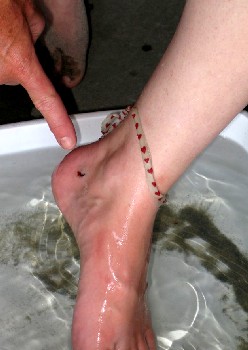
Photo: Wiki: Symac - Bathing a Stingray Injury
Ambroise Paré is the lone surgeon under study from this period to discuss stingray wounds. He begins by describing the symptoms: "the place of the wound doth manfestly appear; there ensue’s thereon lasting pain and numbness of the whole bodie."1 He says that some people die 'forthwith' from the sting with "their whole bodies suffering convulsions."2 While deaths from such stings have occurred, they are rare. Those which are fatal have involved a great deal of blood loss from the wound, stings which have comes in direct contact with a vital organ or extreme complications of the wound.3
Paré's recommendation for cure of ray stings is unusually brief, apparently being taken from discussions with fishermen who have received such wounds. He says "take they forth his liver, and lay it to the wound; furthermore, the fish being burnt and made into powder, is the true antidote of the wound."4 Here again we see sympathetic 'hair of the dog' medicines being suggested. Paré does not mention any medicines or more clinical cures, which is unusual. This again points to his relying on the advice of fisherman and their folk remedies.
Modern procedures recommend bathing ray sting wounds in hot water since stingray venom is broken down by heat.5 It is quite possible that fishermen did so when applying the part of the creature to the wound without realizing that the actual cure was the water.
1,2 Ambroise Paré, The Workes of that Famous Chirurgion Ambrose Parey, 1649, p. 525; 3 Robin J. Slaughter, D. Michael G. Beasley, Bruce S. Lambie and Leo J. Schep, "New England's venemous creatures", The New Zealand Medical Journal, 27 Feb. 2009, gathered from web.archive.org, 11/13/16; 5 Slaughter et. al, gathered 11/13/16

